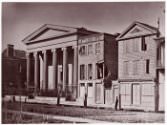Exhibited at the Hibernian Hall, Charleston, 1851–52


Exhibited at the Hibernian Hall, Charleston, 1851–52
After Massachusetts and Connecticut, The Greek Slave traveled south again, although the full trail is unknown. Around this time Powers asked Henry Adams (his sister’s brother-in-law) to take over the tour from Miner K. Kellogg. In a letter dated June 23, 1850, Adams told Powers that he thought the statue “might do well at Charleston, S. Carolina—at St. Louis—Nashville, Pittsburgh, Buffalo, and numerous other places.”[1] The statue was recorded at a number of these cities the following year. From December 29, 1851, until at least January 31, 1852, it was exhibited at the Hibernian Hall, the Greek Revival–style building of the Hibernian Society. Hours were from 9 a.m. to 9 p.m.; admission was a little higher than usual, at 50 cents for a single admission and 75 cents for season tickets.
[1] Adams to Powers, June 23, 1850, Hiram Powers Papers, box 1, folder 13, frame 7, Archives of American Art, Smithsonian Institution.


